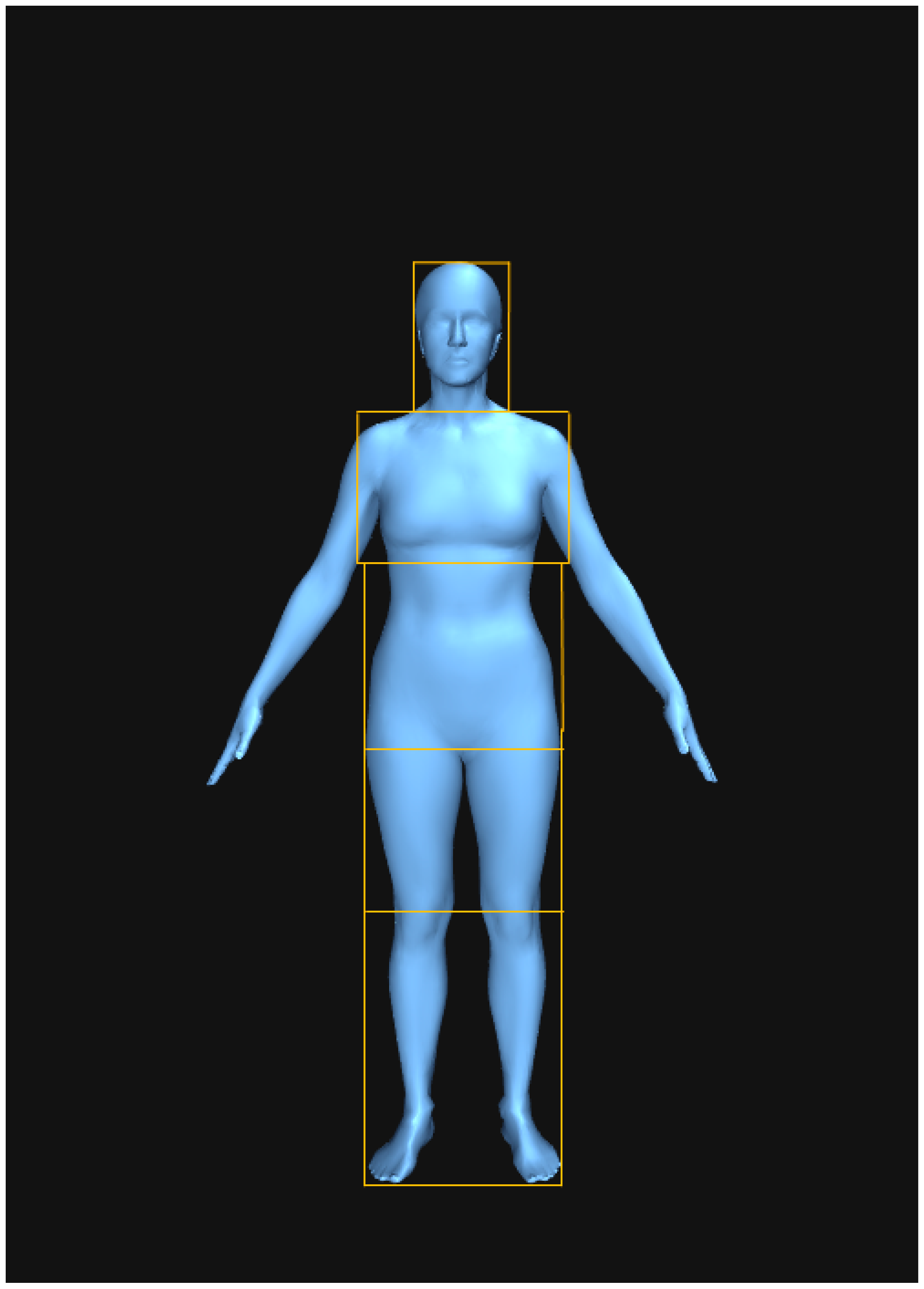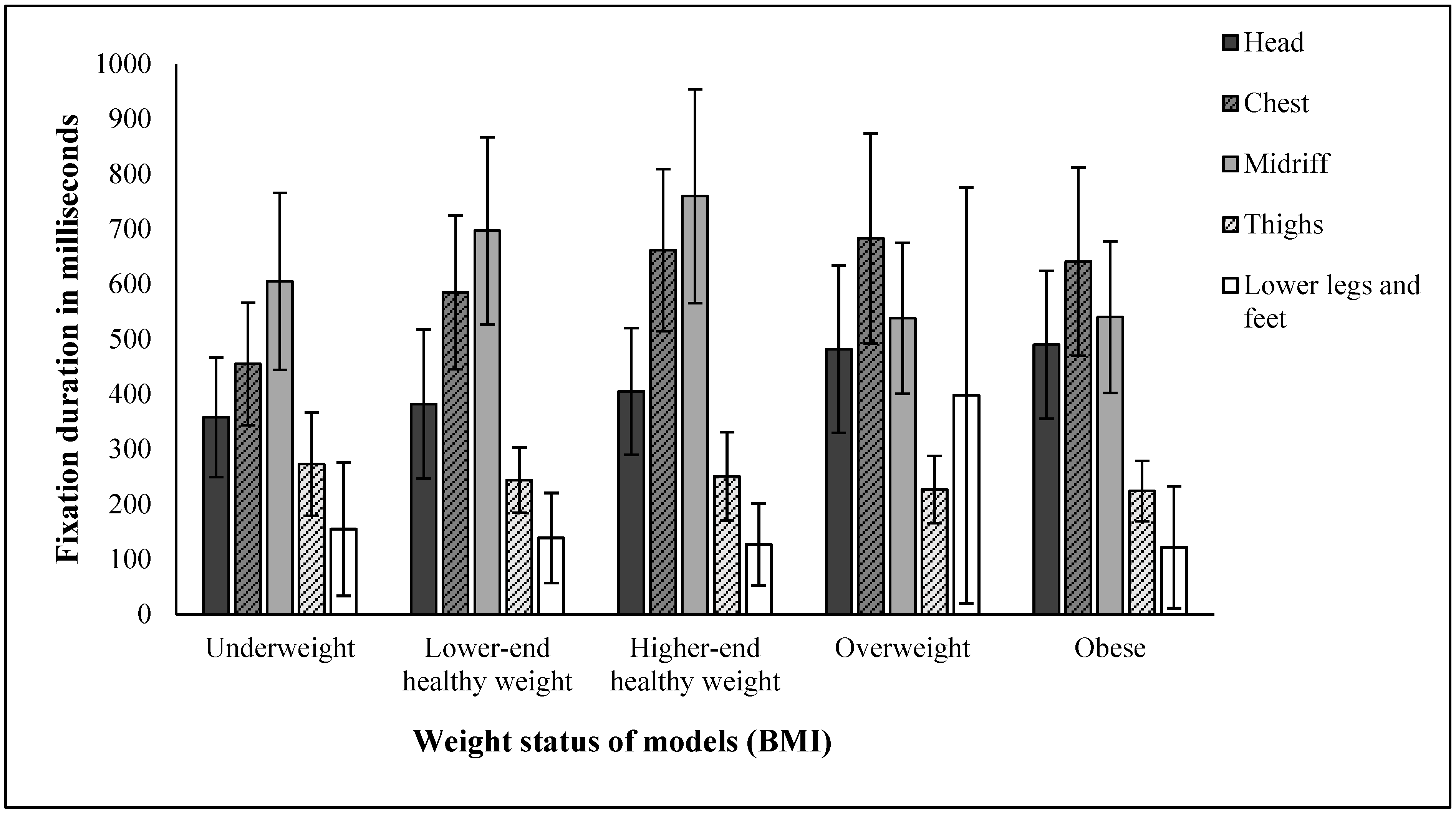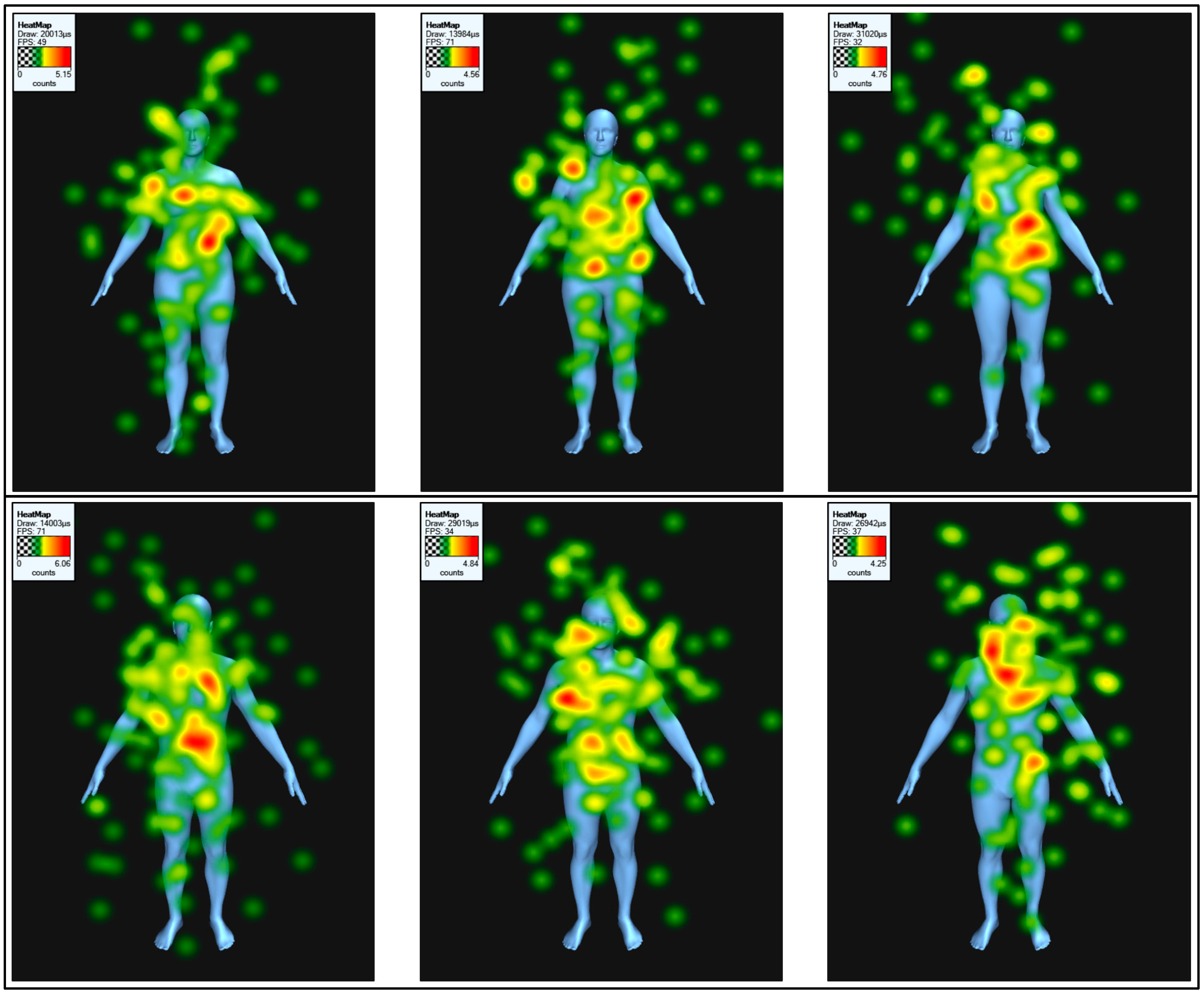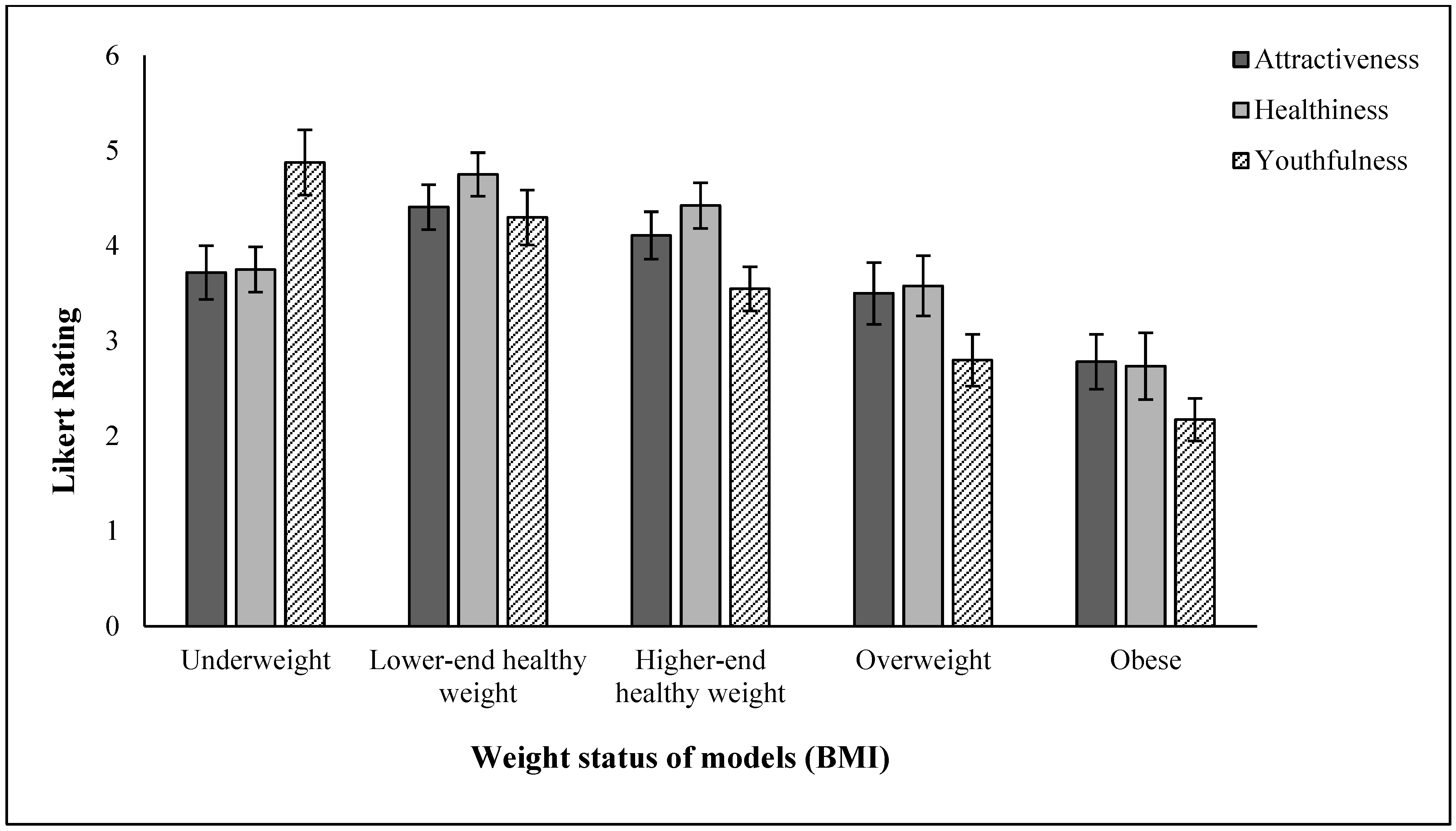Shape of You: Eye-Tracking and Social Perceptions of the Human Body
Abstract
1. Introduction
1.1. Body Size and Attractiveness
1.2. Body Size, Health, and Youth
1.3. Eye-Tracking Attractiveness
1.4. The Present Study
2. Materials and Methods
2.1. Design
2.2. Materials
2.3. Procedure
“Following these instructions, you will be presented with five female images. Please write down your attractiveness ratings of the following images on the response sheet. Please press Spacebar to continue.”
“Record your answer. Please press Spacebar to continue.”
2.4. Analysis
3. Results
3.1. Eye-Gaze Behaviour
3.2. Likert Ratings
4. Discussion
4.1. Findings and Implications
4.2. Limitations and Future Directions
4.3. Conclusions
Author Contributions
Funding
Institutional Review Board Statement
Informed Consent Statement
Data Availability Statement
Acknowledgments
Conflicts of Interest
References
- Ahern, A. L., Bennett, K. M., Kelly, M., & Hetherington, M. M. (2011). A qualitative exploration of young women’s attitudes towards the thin ideal. Journal of Health Psychology, 16(1), 70–79. [Google Scholar] [CrossRef] [PubMed]
- Ahmadi, S., Heyrani, A., & Yoosefy, B. (2018). Prevalence of body shape dissatisfaction and body weight dissatisfaction between female and male students. Journal of Physical Education and Sport, 18(4), 2264–2271. [Google Scholar]
- Andrews, T. M., Lukaszewski, A. W., Simmons, Z. L., & Bleske-Rechek, A. (2017). Cue-based estimates of reproductive value explain women’s body attractiveness. Evolution and Human Behavior, 38(4), 461–467. [Google Scholar] [CrossRef]
- Bird, J. K., Murphy, R. A., Ciappio, E. D., & McBurney, M. I. (2017). Risk of deficiency in multiple concurrent micronutrients in children and adults in the United States. Nutrients, 9(7), 655. [Google Scholar] [CrossRef]
- Boothroyd, L. G., Jucker, J.-L., Thornborrow, T., Barton, R. A., Burt, D. M., Evans, E. H., Jamieson, M. A., & Tovée, M. J. (2020). Television consumption drives perceptions of female body attractiveness in a population undergoing technological transition. Journal of Personality and Social Psychology, 119(4), 839–860. [Google Scholar] [CrossRef]
- Boutari, C., Pappas, P. D., Mintziori, G., Nigdelis, M. P., Athanasiadis, L., Goulis, D. G., & Mantzoros, C. S. (2020). The effect of underweight on female and male reproduction. Metabolism, 107, 154229. [Google Scholar] [CrossRef]
- Brierley, M. E., Brooks, K. R., Mond, J., Stevenson, R. J., & Stephen, I. D. (2016). The body and the beautiful: Health, attractiveness and body composition in men’s and women’s bodies. PLoS ONE, 11(6), e0156722. [Google Scholar] [CrossRef]
- Cornelissen, P. L., Hancock, P. J. B., Kiviniemi, V., George, H. R., & Tovée, M. J. (2009). Patterns of eye movements when male and female observers judge female attractiveness, body fat and waist-to-hip ratio. Evolution and Human Behavior, 30(6), 417–428. [Google Scholar] [CrossRef]
- Crossley, K. L., Cornelissen, P. L., & Tovée, M. J. (2012). What is an attractive body? Using an interactive 3D program to create the ideal body for you and your partner. PLoS ONE, 7(11), e50601. [Google Scholar] [CrossRef]
- Dixson, B. J., Grimshaw, G. M., Linklater, W. L., & Dixson, A. F. (2011). Eye-tracking of men’s preferences for waist-to-hip ratio and breast size of women. Archives of Sexual Behavior, 40(1), 43–50. [Google Scholar] [CrossRef]
- Dixson, B. J., Grimshaw, G. M., Ormsby, D. K., & Dixson, A. F. (2014). Eye-tracking women’s preferences for men’s somatotypes. Evolution and Human Behavior, 35(2), 73–79. [Google Scholar] [CrossRef]
- Dowd, J. B., & Zajacova, A. (2015). Long-term obesity and physical functioning in older Americans. International Journal of Obesity, 39(3), 502–507. [Google Scholar] [CrossRef]
- Drewnowski, A., & Yee, D. K. (1987). Men and body image: Are males satisfied with their body weight? Psychosomatic Medicine, 49(6), 626. [Google Scholar] [CrossRef]
- Erel, C. T., & Senturk, L. M. (2009). The impact of body mass index on assisted reproduction. Current Opinion in Obstetrics and Gynecology, 21(3), 228. [Google Scholar] [CrossRef]
- Faul, F., Erdfelder, E., Lang, A. G., & Buchner, A. (2007). G* Power 3: A flexible statistical power analysis program for the social, behavioral, and biomedical sciences. Behavior Research Methods, 39(2), 175–191. [Google Scholar] [CrossRef]
- Franzoi, S. L., & Herzog, M. E. (1987). Judging physical attractiveness: What body aspects do we use? Personality and Social Psychology Bulletin, 13(1), 19–33. [Google Scholar] [CrossRef]
- Frederick, D. A., & Haselton, M. G. (2007). Why is muscularity sexy? Tests of the fitness indicator hypothesis. Personality and Social Psychology Bulletin, 33(8), 1167–1183. [Google Scholar] [CrossRef]
- Garza, R., Heredia, R. R., & Cieslicka, A. B. (2016). Male and female perception of physical attractiveness: An eye movement study. Evolutionary Psychology, 14(1), 1474704916631614. [Google Scholar] [CrossRef]
- Hack, T. (2014). Forming Impressions: Effects of facial expression and gender stereotypes. Psychological Reports, 114(2), 557–571. [Google Scholar] [CrossRef]
- Han, C., Li, X., Wang, S., Hong, R., Ji, J., Chen, J., Zhu, H., Morrison, E. R., & Lei, X. (2023). The picky men: Men’s preference for women’s body differed among attractiveness, health, and fertility conditions. Personality and Individual Differences, 201, 111921. [Google Scholar] [CrossRef]
- Han, T. S., Morrison, C. E., & Lean, M. E. J. (1999). Age and health indications assessed by silhouette photographs. European Journal of Clinical Nutrition, 53(8), 606–611. [Google Scholar] [CrossRef] [PubMed][Green Version]
- Hargreaves, D. A., & Tiggemann, M. (2009). Muscular ideal media images and men’s body image: Social comparison processing and individual vulnerability. Psychology of Men & Masculinity, 10(2), 109–119. [Google Scholar] [CrossRef]
- Hewig, J., Trippe, R. H., Hecht, H., Straube, T., & Miltner, W. H. R. (2008). Gender differences for specific body regions when looking at men and women. Journal of Nonverbal Behavior, 32(2), 67–78. [Google Scholar] [CrossRef]
- Katta, N., Loethen, T., Lavie, C. J., & Alpert, M. A. (2021). Obesity and coronary heart disease: Epidemiology, pathology, and coronary artery imaging. Current Problems in Cardiology, 46(3), 100655. [Google Scholar] [CrossRef]
- Kenrick, D. T., Neuberg, S. L., Zierk, K. L., & Krones, J. M. (1994). Evolution and social cognition: Contrast effects as a function of sex, dominance, and physical attractiveness. Personality and Social Psychology Bulletin, 20(2), 210–217. [Google Scholar] [CrossRef]
- Khan, Z. A., Khan, T., Bhardwaj, A., Aziz, S. J., & Sharma, S. (2018). Underweight as a risk factor for nutritional anaemia—A cross-sectional study among undergraduate students of a medical college of haryana. Indian Journal of Community Health, 30(1), 63–69. [Google Scholar] [CrossRef]
- Kwon, H., Yun, J. M., Park, J. H., Cho, B. L., Han, K., Joh, H. K., Son, K. Y., & Cho, S. H. (2021). Incidence of cardiovascular disease and mortality in underweight individuals. Journal of Cachexia, Sarcopenia and Muscle, 12(2), 331–338. [Google Scholar] [CrossRef]
- Lassek, W. D., & Gaulin, S. J. (2016). What makes jessica rabbit sexy? Contrasting roles of waist and hip size. Evolutionary Psychology, 14(2), 1474704916643459. [Google Scholar] [CrossRef]
- Luo, Y., & Lin, H. (2021). Inflammation initiates a vicious cycle between obesity and nonalcoholic fatty liver disease. Immunity, Inflammation and Disease, 9(1), 59–73. [Google Scholar] [CrossRef]
- Mayer-Brown, S., Lawless, C., Fedele, D., Dumont-Driscoll, M., & Janicke, D. M. (2016). The effects of media, self-esteem, and BMI on youth’s unhealthy weight control behaviors. Eating Behaviors, 21, 59–65. [Google Scholar] [CrossRef]
- Meeuwsen, S., Horgan, G. W., & Elia, M. (2010). The relationship between BMI and percent body fat, measured by bioelectrical impedance, in a large adult sample is curvilinear and influenced by age and sex. Clinical Nutrition, 29(5), 560–566. [Google Scholar] [CrossRef]
- Meixner, L., Cohrdes, C., Schienkiewitz, A., & Mensink, G. B. M. (2020). Health-related quality of life in children and adolescents with overweight and obesity: Results from the German KIGGS survey. BMC Public Health, 20(1), 1722. [Google Scholar] [CrossRef] [PubMed]
- NatCen Social Research, University College London, Department of Epidemiology and Public Health. (2024). Health survey for England. [data series]. 8th release. UK Data Service. SN: 2000021. [Google Scholar] [CrossRef]
- National Health Service. (2023, February 15). Obesity. Available online: https://www.nhs.uk/conditions/obesity/ (accessed on 8 June 2025).
- Ogden, C. L., Carroll, M. D., Curtin, L. R., McDowell, M. A., Tabak, C. J., & Flegal, K. M. (2006). Prevalence of overweight and obesity in the United States, 1999–2004. Jama, 295(13), 1549–1555. [Google Scholar] [CrossRef] [PubMed]
- Pi-Sunyer, F. X. (1999). Comorbidities of overweight and obesity: Current evidence and research issues. Medicine and Science in Sports and Exercise, 31(Suppl. 11), S602–S608. [Google Scholar] [CrossRef] [PubMed]
- Puhl, R. M., & Heuer, C. A. (2009). The stigma of obesity: A review and update. Obesity, 17(5), 941. [Google Scholar] [CrossRef]
- Rich-Edwards, J. W., Spiegelman, D., Garland, M., Hertzmark, E., Hunter, D. J., Colditz, G. A., Willett, W. C., Wand, H., & Manson, J. E. (2002). Physical activity, body mass index, and ovulatory disorder infertility. Epidemiology, 13(2), 184–190. [Google Scholar] [CrossRef]
- Risi, R., Tuccinardi, D., Mariani, S., Lubrano, C., Manfrini, S., Donini, L. M., & Watanabe, M. (2021). Liver disease in obesity and underweight: The two sides of the coin. A narrative review. Eating and Weight Disorders—Studies on Anorexia, Bulimia and Obesity, 26(7), 2097–2107. [Google Scholar] [CrossRef]
- Robinson, E., & Kersbergen, I. (2017). Overweight or about right? A norm comparison explanation of perceived weight status. Obesity Science & Practice, 3(1), 36–43. [Google Scholar] [CrossRef]
- Rule, N., & Ambady, N. (2010). First impressions of the face: Predicting success. Social and Personality Psychology Compass, 4(8), 506–516. [Google Scholar] [CrossRef]
- Rupp, H. A., & Wallen, K. (2008). Sex differences in response to visual sexual stimuli: A review. Archives of Sexual Behavior, 37, 206–218. [Google Scholar] [CrossRef] [PubMed]
- Sakamoto. (2006). The situation of the epidemiology and management of obesity in Japan. International Journal for Vitamin and Nutrition Research, 76(4), 253–256. [Google Scholar] [CrossRef] [PubMed]
- Sell, A., Lukazsweski, A. W., & Townsley, M. (2017). Cues of upper body strength account for most of the variance in men’s bodily attractiveness. Proceedings of the Royal Society B: Biological Sciences, 284(1869), 20171819. [Google Scholar] [CrossRef] [PubMed]
- Sharafi, S. E., Garmaroudi, G., Ghafouri, M., Bafghi, S. A., Ghafouri, M., Tabesh, M. R., & Alizadeh, Z. (2020). Prevalence of anxiety and depression in patients with overweight and obesity. Obesity Medicine, 17, 100169. [Google Scholar] [CrossRef]
- Singh, D. (2002). Female mate value at a glance: Relationship of waist-to-hip ratio to health, fecundity and attractiveness. Neuroendocrinology Letters, 23(4), 81–91. [Google Scholar]
- Spinner, P., Gass, S. M., & Behney, J. (2013). Ecological validity in eye-tracking: An empirical study. Studies in Second Language Acquisition, 35(2), 389–415. [Google Scholar] [CrossRef]
- Swami, V. (2015). Cultural influences on body size ideals. European Psychologist, 20(1), 44–51. [Google Scholar] [CrossRef]
- Swami, V., Tovée, M., & Furnham, A. (2007). Healthy body equals beautiful body? Changing perceptions of health and attractiveness with shifting socioeconomic status (pp. 108–128). Palgrave Macmillan. [Google Scholar] [CrossRef]
- Tovée, M. J., Maisey, D. S., Emery, J. L., & Cornelissen, P. L. (1999a). Visual cues to female physical attractiveness. Proceedings of the Royal Society of London. Series B: Biological Sciences, 266(1415), 211–218. [Google Scholar] [CrossRef]
- Tovée, M. J., Maisey, D. S., Vale, E. L., & Cornelissen, P. L. (1999b). Characteristics of male attractiveness for women. The Lancet, 353(9163), 1500. [Google Scholar] [CrossRef]
- Tovée, M. J., Reinhardt, S., Emery, J. L., & Cornelissen, P. L. (1998). Optimum body-mass index and maximum sexual attractiveness. The Lancet, 352(9127), 548. [Google Scholar] [CrossRef]
- Tovée, M. J., Swami, V., Furnham, A., & Mangalparsad, R. (2006). Changing perceptions of attractiveness as observers are exposed to a different culture. Evolution and Human Behavior, 27(6), 443–456. [Google Scholar] [CrossRef]
- Trent, J., & Ferguson, Y. (2021). How ethnicity, expression, and study design influence first impressions of approachability. Psychological Reports, 124(2), 862–895. [Google Scholar] [CrossRef]
- Van Amsterdam, N. (2013). Big fat inequalities, thin privilege: An intersectional perspective on ‘body size’. European Journal of Women’s Studies, 20(2), 155–169. [Google Scholar] [CrossRef]
- Varela, V. P. L., Towler, A., Kemp, R. I., & White, D. (2023). Looking at faces in the wild. Scientific Reports, 13(1), 783. [Google Scholar] [CrossRef] [PubMed]
- Williams, E. P., Mesidor, M., Winters, K., Dubbert, P. M., & Wyatt, S. B. (2015). Overweight and obesity: Prevalence, consequences, and causes of a growing public health problem. Current Obesity Reports, 4, 363–370. [Google Scholar] [CrossRef]
- Willis, J., & Todorov, A. (2006). First impressions: Making up your mind after a 100-ms exposure to a face. Psychological Science, 17(7), 592–598. [Google Scholar] [CrossRef]
- Wondmkun, Y. T. (2020). Obesity, insulin resistance, and Type 2 Diabetes: Associations and therapeutic implications. Diabetes, Metabolic Syndrome and Obesity, 13, 3611–3616. [Google Scholar] [CrossRef]
- Yancy, W. S., Jr., Olsen, M. K., Westman, E. C., Bosworth, H. B., & Edelman, D. (2002). Relationship between obesity and health-related quality of life in men. Obesity Research, 10(10), 1057–1064. [Google Scholar] [CrossRef]







| Fixed Effects | Fixation Duration (F(df), p) | Number of Fixations (F(df), p) |
|---|---|---|
| Main effects | ||
| Model sex | F(1,4746) = 12.14, p < 0.001 | F(1,4746) = 26.65, p < 0.001 |
| BMI | F(4,4746) = 1.95, p = 0.100 | F(4,4746) = 3.00, p = 0.057 |
| Rating | F(2,4746) = 0.55, p = 0.578 | F(2,4746) = 0.74, p = 0.479 |
| AOI | F(4,4746) = 139.98, p < 0.001 | F(4,4746) = 180.90, p < 0.001 |
| 2-way interactions | ||
| Model sex × BMI | F(4,4746) = 1.39, p = 0.236 | F(4,4746) = 2.16, p = 0.070 |
| Model sex × rating | F(2,248) = 4.89, p = 0.008 | F(2,248) = 3.87, p = 0.021 |
| Model sex × AOI | F(4,4746) = 1.72, p = 0.141 | F(4,4746) = 3.17, p = 0.013 |
| Rating × BMI | F(8,4746) = 1.35, p = 0.212 | F(4,4746) = 2.46, p = 0.012 |
| BMI × AOI | F(16,4746) = 2.79, p < 0.001 | F(8,4746) = 1.31, p = 0.178 |
| Rating × AOI | F(8,4746) = 2.89, p = 0.003 | F(16,4746) = 2.58, p = 0.008 |
| Rating | Female | Male |
|---|---|---|
| Fixation duration (ms) | ||
| Attractiveness | 363 (286–441) | 473 (395–550) |
| Healthiness | 369 (298–440) | 444 (363–524) |
| Youthfulness | 403 (327–479) | 391 (311–470) |
| Number of fixations | ||
| Attractiveness | 0.79 (0.65–0.94) | 1.04 (0.90–1.12) |
| Healthiness | 0.80 (0.64–0.96) | 0.96 (0.81–1.10) |
| Youthfulness | 0.86 (0.70–1.00) | 0.90 (0.73–1.08) |
| AOI | Female | Male |
|---|---|---|
| Head | 0.83 (0.62–1.04) | 0.96 (0.73–1.19) |
| Chest | 1.21 (0.97–1.45) | 1.46 (1.20–1.71) |
| Midriff | 1.16 (0.96–1.36) | 1.45 (1.21–1.70) |
| Thighs | 0.57 (0.45–0.70) | 0.66 (0.51–0.81) |
| Lower legs | 0.31 (0.16–0.46) | 0.31 (0.16–0.47) |
| Attractiveness | Healthiness | Youthfulness | |
|---|---|---|---|
| # fixations | |||
| Underweight | 0.77 (0.58–0.94) | 0.85 (0.67–1.03) | 0.80 (0.62–0.98) |
| Low healthy | 0.85 (0.69–1.02) | 0.99 (78–1.20) | 0.86 (0.65–1.07) |
| High healthy | 1.07 (0.92–1.22) | 0.88 (0.71–1.04) | 0.86 (0.68–1.04) |
| Overweight | 0.90 (0.75–1.06) | 0.81 (0.63–0.99) | 0.99 (0.81–1.17) |
| Obese | 0.99 (0.93–1.14) | 0.87 (0.68–1.05) | 0.89 (0.74–1.04) |
| Fixed Effects | Likert Score |
|---|---|
| Main effects | |
| Model sex | F(1,930) = 3.79, p = 0.052 |
| BMI | F(4,930) = 122.37, p < 0.001 |
| Rating | F(2,930) = 8.30, p < 0.001 |
| 2-way interactions | |
| Model sex × BMI | F(4,930) = 19.25, p < 0.001 |
| Model sex × rating | F(2,930) = 5.79, p < 0.001 |
| Rating × BMI | F(8,9306) = 15.02, p < 0.001 |
| 3-way interaction | |
| Mode sex × BMI × rating | F(8,930) = 4.73, p < 0.001 |
| Rating (1–6) | Female | Male |
|---|---|---|
| Attractiveness | 3.79 (3.51–4.07) | 3.61 (3.37–3.85) |
| Healthiness | 4.02 (3.77–4.23) | 3.68 (3.47–3.88) |
| Youthfulness | 3.46 (3.22–3.69) | 3.62 (3.42–3.82) |
Disclaimer/Publisher’s Note: The statements, opinions and data contained in all publications are solely those of the individual author(s) and contributor(s) and not of MDPI and/or the editor(s). MDPI and/or the editor(s) disclaim responsibility for any injury to people or property resulting from any ideas, methods, instructions or products referred to in the content. |
© 2025 by the authors. Licensee MDPI, Basel, Switzerland. This article is an open access article distributed under the terms and conditions of the Creative Commons Attribution (CC BY) license (https://creativecommons.org/licenses/by/4.0/).
Share and Cite
Morrison, E.; Lanigan, M. Shape of You: Eye-Tracking and Social Perceptions of the Human Body. Behav. Sci. 2025, 15, 817. https://doi.org/10.3390/bs15060817
Morrison E, Lanigan M. Shape of You: Eye-Tracking and Social Perceptions of the Human Body. Behavioral Sciences. 2025; 15(6):817. https://doi.org/10.3390/bs15060817
Chicago/Turabian StyleMorrison, Edward, and Marianne Lanigan. 2025. "Shape of You: Eye-Tracking and Social Perceptions of the Human Body" Behavioral Sciences 15, no. 6: 817. https://doi.org/10.3390/bs15060817
APA StyleMorrison, E., & Lanigan, M. (2025). Shape of You: Eye-Tracking and Social Perceptions of the Human Body. Behavioral Sciences, 15(6), 817. https://doi.org/10.3390/bs15060817





